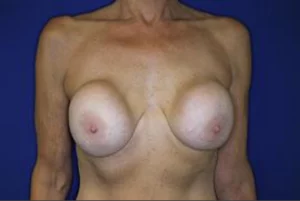Capsular Contracture Treatment Los Angeles
- View Dr Diaz’s amazing Before & After results!
- Learn more about Capsular Contracture and how you can have the breasts you always wanted again.
- Dr. Diaz is one of the most sought after Surgeons in Los Angeles. He is a diamond member of Allergan, placing him in the top 3% of all Surgeons in the country.
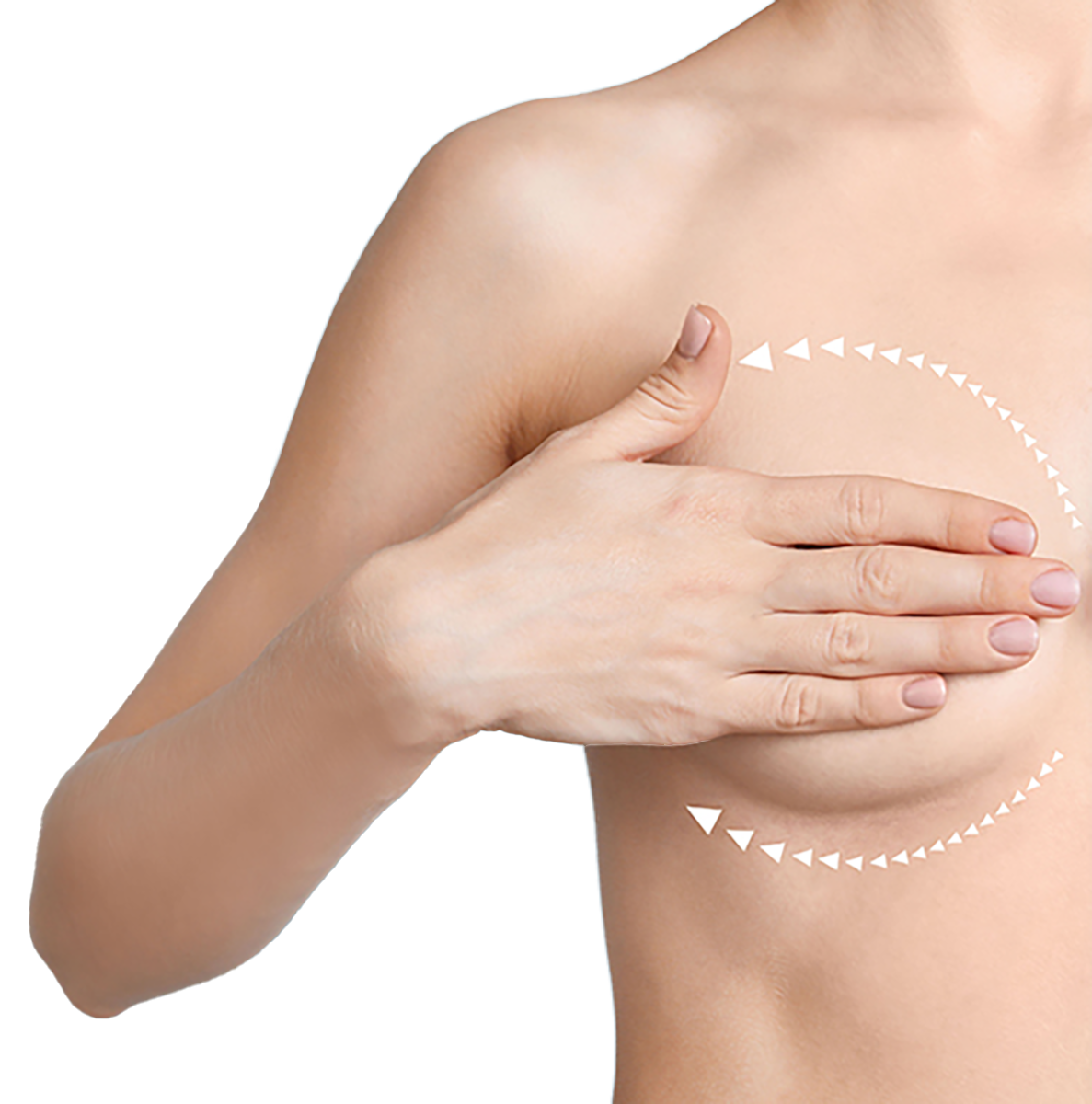
Allergan Diamond Status
Top 3% Of Plastic Surgeons In The Nation.
Google / Yelp / RealSelf
4.9 Star Rating / 515 Reviews
Highest Antibacterial Standards
One of the lowest rates of infection after surgery in the world.
1,000s Of Surgerys
One of the lowest rates of infection after surgery in the world.
Alpha Omega Alpha Award
Top 10% Of Medical Students In The Nation
Capsular contracture is a frustrating and disappointing problem. Often, when capsular contracture occurs, it causes other problems with the breasts, such as pain, asymmetry in size, asymmetry in shape and unsightly scarring or healing. Fortunately there are numerous options available to help correct it. Some of these options don’t involve surgery. However, surgical correction will be needed when non invasive treatments don’t work.
In this website, I review all of the available information about capsular contracture. I also review all of the available non surgical treatments. There are also videos of the surgery and before and after photos of patients.
Capsular Contracture Surgery Types & Procedures Involved:
If non surgical treatments of capsular contracture are unsuccessful, surgery will be required. The exact surgical procedure, or set of procedures, needed to correct capsular contracture will depend on how severe the contracture is. In general, the more severe the contracture is, the more likely it will be to require multiple steps to fully correct it. These steps may or may not include removal of the implants, replacement of the implants, capsulotomy, capsulectomy, changing of implant pocket, application of acellular dermal matric and possible breast reshaping.
- CAPSULOTOMY
- CAPSULECTOMY
- CHANGE OF IMPLANT POCKET
- INSERTION OF NEW IMPLANTS
- APPLICATION OF ACELLULAR DERMAL MATRIX (ADM) OR SURGICAL SILL SCAFFOLD (SERI)
- BREAST RESHAPING
What can happen to implants because of capsular contracture:
Ruptured Silicone Implant
Due to capsular contracture.
![]()
Creased Silicone Implant
Caused by pressure from capsular contracture at approximately 11 O’clock.

There are numerous surgical options to treat capsular contracture. More severe capsular contracture requires a combination of techniques to achieve the best result. These include removal of the affected implants, capsulotomy, capsulectomy, insertion of new implants, application of ADM or SERI and breast reshaping. The exact technique, or combination of techniques needed can be determined only after a thorough consultation has been completed.
WHAT IS CAPSULAR CONTRACTURE?
When anything is placed in the tissues of the human body, a very thin layer of scar tissue forms around it. This is true whether it is an artificial hip or a breast implant that is inserted. The scar tissue wraps around the implant like a bag. Normally, the scar tissue is very thin and almost transparent. You wouldn’t even know it is there. That is why it is normally not a problem. However, for reasons that are not well understood, the scar tissue can gradually, or suddenly, become thicker and firmer. As the scar tissue thickens and firms, it tightens around the implant. The normally soft feeling implant then becomes firm to the touch. When this happens, it is called Capsular Contracture. If the scar tissue tightens more, it squeezes on the implant causing it to appear very round and “high.” If the scar worsens, there may even be pain.
This is an example of a severe case of capsular contracture (In the left breast).
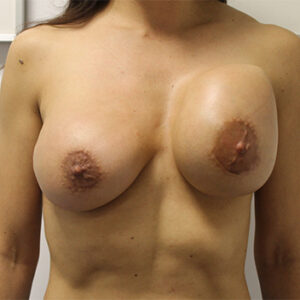
Unfortunately, Capsular Contracture is the most common complication associated with breast augmentation. The percent chance of it occuring varies greatly. In some cases, it can be as low as 1% or as high as 20%. Also, capsular contracure can happen at any time. Some patients develop it years after their surgery.
Dr. Diaz’s rate of capsular contracture has been studied and is 1%, which is the lowest rate observed.
The capsule is made of a combination of scar tissue and other cells. The scar tissue is composed of abnormally organized collagen fibers. There may also be cells, called myofibroblasts, present. Myofibroblasts can contract, similar to muscle cells, and cause the tightening and shrinking of the capsule.
The breast may not change very much in appearance in mild cases of capsular contracure. These mild cases may respond to non surgical treatments to correct it. However, if capsular contracture progresses, it can cause distortion of the breast shape and even pain. Once capsular contracture is advanced, only surgical treatments will be successful at correction.
This is a photo of a thin capsule around an implant.
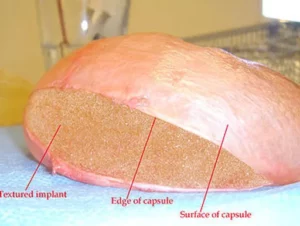
This is a photo of an implant after it was removed from a severely thickened and hardened capsule. Note how much smaller the capsule is. This created severe tightening of the implant and resulted in distortion of the patient’s breast shape.

WHAT CAUSES CAPSULAR CONTRACTURE?
AND WHAT CAN BE DONE TO PREVENT IT
Unfortunately, there is no one single explanation or cause of capsular contracture. In fact, despite numerous detailed studies, capsular contracture remains poorly understood. However, all of the scientific research done over the past several decades has shed some light on capsular contracture and there are some theories to help explain why it sometimes happens. It is important to remember, as one reviews these theories, that many cases of capsular contracture can happen without any apparent cause.
EXCESSIVE BLOOD IN THE BREAST POCKET
One possible cause of capsular contracture is the presence of excess blood in the breast pocket. This usually occurs during the initial surgery. If there is an excessive amount of bleeding, or the blood that collects in the breast pocket is not removed or cleaned out prior to inserting the implant, this excess blood can stimulate the inflammatory process that leads to capsular contracture.
Capsular contracture may also be caused by a hematoma. A hematoma is a collection of blood that forms after surgery. When it occurs, the breast becomes very swollen and painful. Once this happens, surgery is required to remove the blood. Studies show an increased risk of capsular contracure if someone develops a hematoma after breast surgery.
These are pictures of Dr. Diaz’s technique. When the finger is removed, you can see there is no blood whatsoever on the glove. The breast pocket is meticulously dissected and there is no bleeding present.
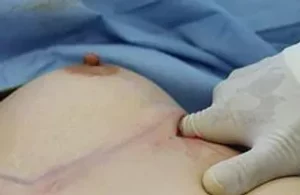
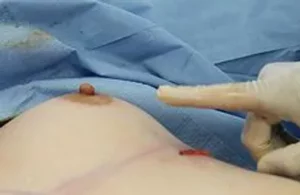
If someone develops capsular contracture, it does not mean that they must have had excess bleeding or a hematoma. Capsular contracture is sometimes caused by unknown reasons. This is just one theory, of many, that may explain some cases of capsular contracture.
Dr. Diaz prevents bleeding during breast surgery through his careful and meticulous operative technique. You can see this in the pictures above. You can also click on his video at the bottom of this page to see how carefully he performs a breast augmentation.
PRESENCE OF BACTERIA IN BREAST POCKET OR ON THE BREAST IMPLANT
There are many studies which show that the presence of bacteria on the implant or in the breast can cause capsular contracture. The presence of even a few bacterial cells (which would not cause any infection) may lead to an inflammatory process that results in capsular contracture. This is called a “subclinical” infection because the amount of bacteria involved is so small (“sub”) that there will not be an infection visible (“clinical”). The theory is that these few cells of bacteria in the breast pocket and on the implant produce a thin film of molecules on the implant surface called a “biofilm”. The biofilm may be responsible for setting off the process that leads to capsular contracture.
There are many things Dr. Diaz does to prevent the chance of bacteria contaminating the breast pocket or breast implant during surgery. One thing is to use an inframammary incision (under the breast). This incision avoids the nipple and areola, as well as the underarm area, which are areas that are normally covered and filled with a large amount of bacteria.
Another stratgey Dr. Diaz uses to prevent bacteria from contaminating the implant is to wash the breast skin very carefully at the start of the surgery and again right before he inserts the implant. The antibiotic solution is dark in color. This step ensures that the skin in the area is as sterile as possible.
Dr. Diaz also washes his gloves thoroughly with an antibiotic solution before handling the implant. This ensures there is no contamination of his gloves.

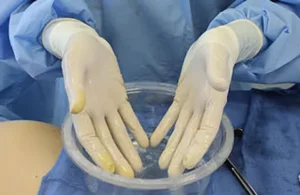
Lastly, Dr. Diaz uses a “No Touch” technique to insert the implant. This means he does not touch the implant during the surgery, therefore keeping it perfectly sterile. After opening the implant package, the implant is carefully placed inside a Keller Funnel. The Keller Funnel is then used to insert the implant into the breast.
This is a picture of the implant package immediately after it has been opened. / This picture shows the implant being immediately placed into the Keller Funnel. These steps prevent contamination of the implant.
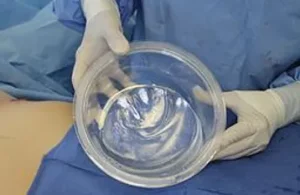
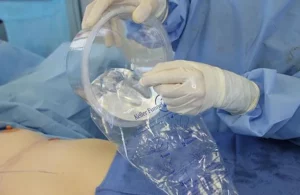
Very few surgeons take as many steps as Dr. Diaz does to prevent capsular contracture. This is why he has one of the lowest rates of capsular contracture of any surgeon in the world.
This picture shows Dr. Diaz inserting the implant using the Keller Funnel. / This shows the breast immediately after the implant is inserted.
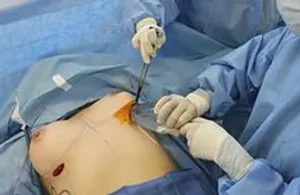

It is important to remember that capsular contracture may also occur for unknown reasons. It does not mean that the person must have had bacterial contamination. This is just one theory as to why it may occur.
MICROSCOPIC CONTAMINATION OF BREAST POCKET
Another theory is that contamination of the implant, or of the breast, with very small or microscopic particles can lead to capsular contracure. These particles may be particles in the air, or fibers from the drapes, towels and sponges used during surgery. The presence of these particles may stimulate an inflammatory reaction in the breast which may ultimately lead to capsular contracture.
Dr. Diaz prevents contamination of the implant and of the breast by employing the numerous special techniques described above.
Just because a patient develops capsular contracture, it does not mean that there must have been contamination of the breast or implant. Capsular contracture is also caused by unknown reasons.
INJURY TO MUSCLE AND BREAST TISSUES
Another theory is that rough handling of the breast tissues and/or muscle may lead to capsular contracure. If the dissection is not meticulously performed, there could be unintentional injury to the muscle or the breast tissue. Most of the time, this minor “bruising” does not result in capsular contracture or other complications. However, it is possible that it can lead to inflammation which can stimulate the formation of capsular contracture.
If someone develops capsular contracture, it does not mean that their tissues must have been handled roughly. Capsular contracture can also happen for unknown reasons.
OTHER THEORIES
Many patients will ask if capsular contracture was caused by their body “rejecting” the implant. This does not happen. There is no evidence of an immune system reaction to the implant. There is also no evidence of the body “rejecting” the implant. This is a misconception.
The silicone in a breast implant is an “inert” material. This means that the body does not form an immune reaction to it. Capsular contracture represents an inflammatory process, not an immune system reaction.
Complications after breast surgery, such as the need to remove the implant, can occur. However, this is caused by things such as excess bleeding, infection or severe capsular contracture. It is not a result of the body’s immune system “rejecting” the implant.
Capsular contracture remains a poorly understood complication after breast surgery. There are several theories as to what can cause it. These include excess blood in the breast pocket, the presence of bacteria in the breast or on the implant, contamination of the breast or implant with microscopic particles and rough handling of the breast tissues and muscle.
Patients can develop capsular contracture even when there is no evidence of bleeding, bacteria, contamination or rough handling of tissues. Therefore, there may be, as of yet, unknown reasons why capsular contracure may occur.
Symptoms & Diagnosis Of Capsular Contracture
Capsular contracure is diagnosed based on the symptoms and the physical exam. Firmness of the breasts which has worsened over time is a sign of capsular contracture. Once capsular contracture is diagnosed, it is classified into a grade. The most commonly used system is the Baker Classification of Capsular Contracture. This classification system is summarized below.
BAKER GRADE 1
There is no palpable capsule. The breast feels as soft as an unoperated one.
This is normal and no treatment is necessary.
BAKER GRADE 2
There is minimal firmness. The breast is less soft, and the implant can be palpated.
May improve with breast massages and/or medications.
BAKER GRADE 3
There is moderate firmness. The breast is harder, the implant can be easily felt, the implant can be easily seen and the breast shape is mildly distorted.
Surgery is usually necessary. Medications may soften the breast, but will not correct the condition. If not treated, may progress to Baker Grade 4.
BAKER GRADE 4
This is severe contracture. The breast is hard, tender to the touch, painful and may feel cold. The breast shape is markedly distorted.
Surgery is necessary to correct this.
About Dr. John Diaz
Dr. John Diaz is an Ivy League graduate from Cornell University. He received a scholarship to attend the prestigious Albert Einstein College of Medicine in New York. Dr. Diaz graduated medical school with the highest honors and for this he received the Alpha Omega Alpha Award, which is given to only the top 10% of medical students in the country.
He completed his training in Plastic and Reconstructive Surgery in N.Y.C. where he had the privilege of working alongside some of the most famous plastic surgeons in the world. Dr. Diaz is a published author of articles on plastic surgery. He received a degree with Distinction in Plastic Surgery Research for his work.
He has received awards from the New York Regional Society of Plastic Surgery, Montefiore Medical Center and the Albert Einstein College of Medicine. Dr. Diaz is a medical staff member of the renowned Cedars Sinai Medical Center in Los Angeles, CA and has a private practice in Beverly Hills. He is the Past President of the Los Angeles Society of Plastic Surgeons and has presented lectures on plastic surgery throughout the United States.
He has been featured as a plastic surgery expert on a variety of television programs including CNN, Dr. Drew’s Lifechangers, and HLN, to name a few.
Dr. John Diaz is a board certified plastic surgeon in Beverly Hills, CA
![]()
![]()
![]()



![]()

PATIENT REVIEWS
ALMOST 20 YEARS OF EXPERIENCE. THOUSANDS OF HAPPY PATIENTS.
HUNDREDS OF FIVE STAR REVIEWS.
HIGHEST OVERALL RATED PLASTIC SURGEON IN LOS ANGELES
Media
DR. JOHN DIAZ IS ONE OF THE TOP PLASTIC SURGEONS IN LOS ANGELES.

LA Magazine just recognized Dr. John Diaz as one of the best plastic surgeons in Beverly Hills and Los Angeles. He has also published a book entitled Comprehensive Guide to Breast Augmentation.
DR. DIAZ ON INSTAGRAM
Frequently Asked Questions
Is capsular contracture covered by insurance?
Initially Surgery Because of Cosmetic Reasons:
No, usually health insurance does not pay to fix capsular contracture, if the initial surgery was done for cosmetic only reasons.
Breast Reconstruction After Breast Cancer:
Yes, health insurance usually will pay to remove the implants if capsular contracture occurs later.
Patients should contact their insurance provider directly to inquire about coverage for capsular contracture treatment. It’s important to provide detailed information about the symptoms, any functional impairment, and the medical necessity of the proposed treatment. Additionally, documentation from the treating physician may be required to support the insurance claim.
Patients should thoroughly review their insurance policy and discuss the specific circumstances with their healthcare provider and insurance company to determine coverage eligibility for capsular contracture treatment.
Related Readings:
- Need Breast Revision? (Find out more here)




